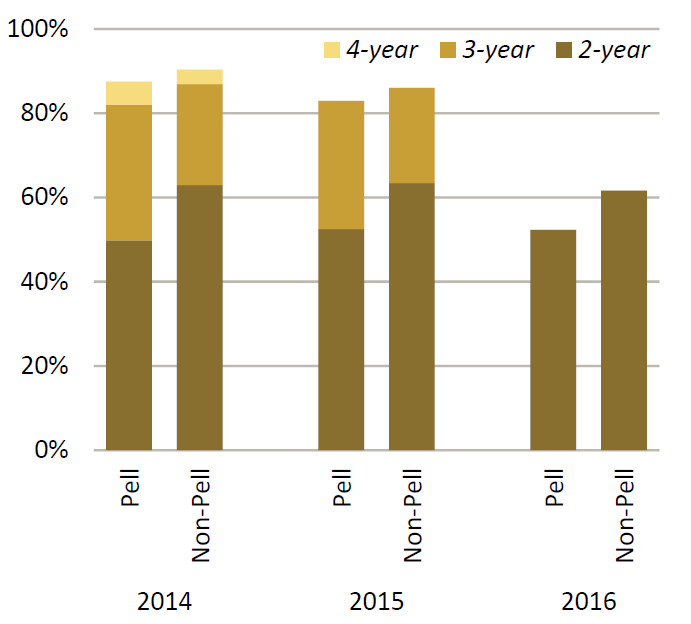Executive Summary
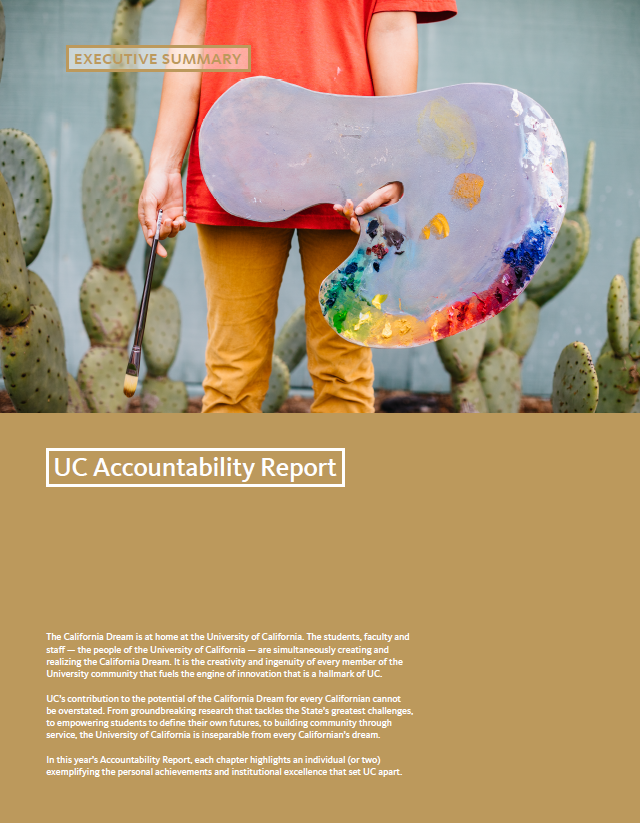
The California Dream is at home at the University of California. The students, faculty, and staff—the people of the University of California—are simultaneously creating and realizing the California Dream. It is the creativity and ingenuity of every member of the University community that fuels the engine of innovation that is the hallmark of UC.
UC’s contribution to the potential of the California Dream for every Californian cannot be overstated From groundbreaking research that tackles the State’s greatest challenges, to empowering students to define their own futures, to building community through service, the University of California is inseparable from every Californian’s dream.
In this year’s Accountability Report, each chapter highlights an individual (or two) exemplifying the personal achievements and institutional excellence that set UC apart.
As part of its transparency efforts, the University of California produces the UC Accountability Report to provide greater awareness of University operations. This report, along with the online UC Information Center (ucal.us/infocenter), allows the public to learn more about the University, and UC leadership to identify areas of strength and opportunities for improvement for the system and UC campuses. The 2019 UC Accountability Report Executive Summary highlights accountability indicators relevant to goals associated with the University of California’s multi-year plan: UC 2030. This plan is a collective effort of UC leadership — the President, Chancellors, and Board of Regents — to identify campus and systemwide goals that address current struggles facing the state, and opportunities to strengthen California.
Strengthening UC’s Contributions to the California Dream
People have always come to California for a better life and a new start. From early in its history as a state, economic growth from emerging industries has benefited Californians with employment, increased earnings, and home ownership. And education made a better future possible for students and their families, along with the state. The State of California’s investment in the University of California did something unique by providing the benefits of accessible public education in a research environment that rivaled that of the Ivy League. The research function attracts billions of dollars and talent into the state and generates creative works and research discoveries that better the state, the nation, and the world. The University of California has been instrumental to making a better future for Californians a reality. As California has grown, so has the University. In response to a soaring college-bound Baby Boomer population in the 1950s, the state partnered with the University of California to open five new campuses in northern and southern California, allowing UC enrollment to nearly quadruple over the next sixty years. UC’s newest campus, located in the Central Valley, enrolls students from an under-served region of the state while also stimulating the local economy. Today, the University has ten campuses with over 280,000 undergraduate and graduate students, and more than two million alumni. UC also runs three national energy laboratories (two in California), along with operating the state’s fourth-largest health care delivery system and serving as the state’s third-largest employer.
Undergraduate and graduate student enrollment, with campus opening date, Fall 1868 to 2018

California’s investment in the University has advanced the California Dream, especially for the large proportion of low-income students that UC enrolls. Almost 40 percent of undergraduates are low-income, nearly twice that of American Association of Universities (AAU) public institutions and more than twice that of AAU private institutions. A UC education is a ladder for economic mobility; five years after graduation, the majority of UC Pell Grant recipients who leave with a degree earn more than their parents.
UC enrolls a higher percentage of Pell Grant recipients than public or private peers.
2.2.1 Undergraduate Pell Grant recipients, UC and comparison institutions, 2016–17
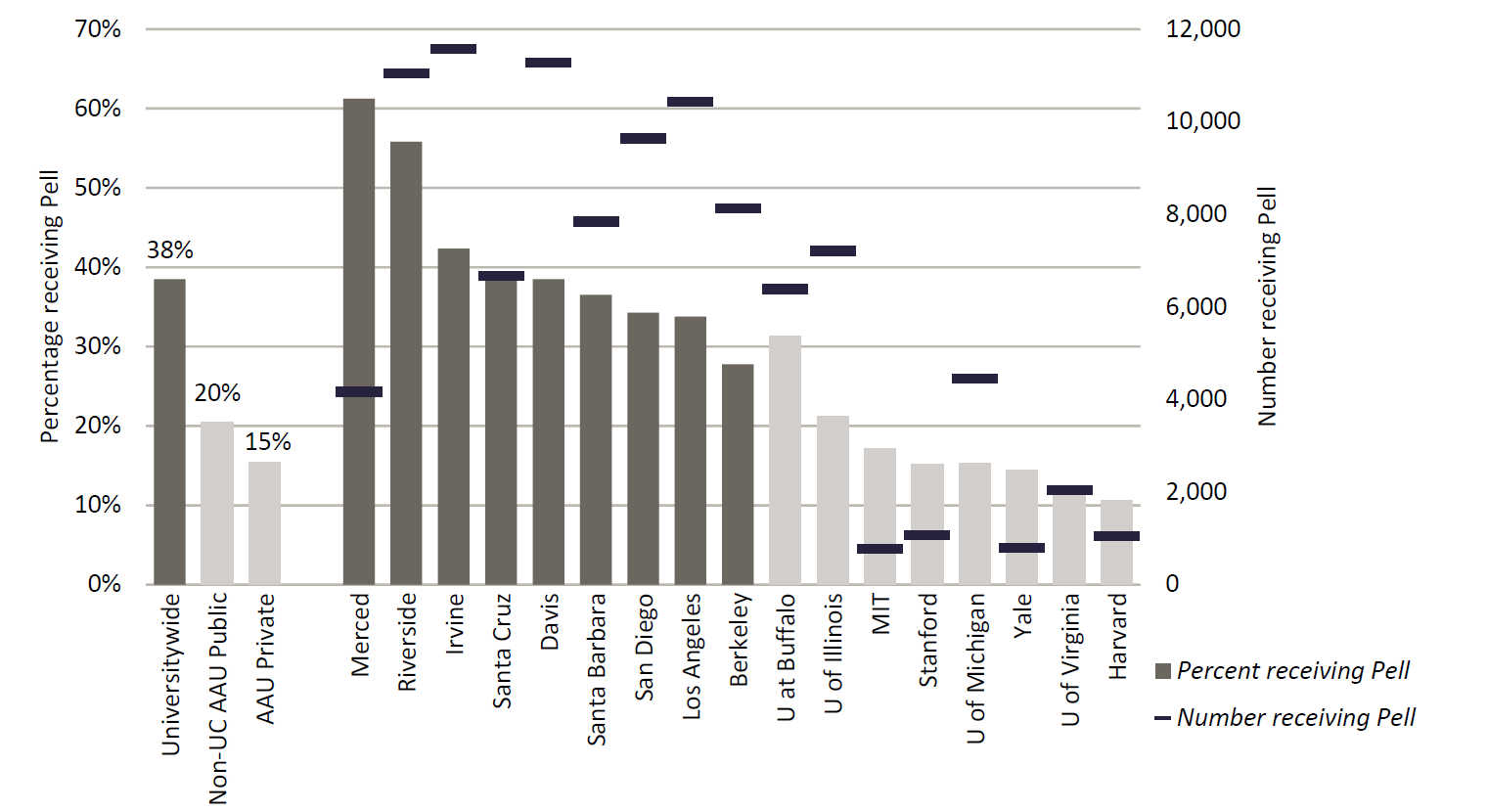
Source: IPEDS
UC graduate education supports critical workforce needs and advances the University’s research enterprise. UC graduate students produce almost 600 new inventions a year, resulting in a startup being formed every two weeks, on average. In addition, UC doctoral recipients serve as the next generation of the professoriate with 25 percent of UC tenure and tenure-track faculty and 21 percent of California State University tenure and tenure-track faculty having earned their doctorate from UC. Furthermore, UC produces 70 percent of California’s STEM (science, technology, engineering, and math) doctoral degrees and half of California’s health care residents. California’s investment in UC faculty and their research continues to yield a significant return. Over the past two decades, UC has secured more licensable patents than any other U.S. research university. Since 1976, over 1,000 startup companies have been founded around UC inventions, with about 85 percent based in California. UC researchers submit, on average, five new inventions a day in many diverse areas, including agriculture, technology, biotech, and clean energy. As examples illustrating this impact, UC research:
- removed the salts from alkaline soils in the Central Valley to produce the world’s most productive farming region, moving California from 27th in the country to a leader in state agricultural production;
- transformed AIDS from a terminal illness to a survivable condition, and produced discoveries to treat other critical health care needs like breast cancer, Alzheimer’s, and other diseases;
- launched the internet and spurred the information technology, biotech, and entertainment industries.
UC research has helped California become the fifth-largest economy in the world.
UC 2030: Advancing the California Dream
Today, California is at a crossroads; too many Californians are struggling with diminished economic opportunity, a high cost of living, and a lack of affordable housing. California’s Baby Boomers are also retiring, marking the first time in California’s history that such a large and well-educated group will exit the labor force. Furthermore, California faces significant threats from the growing damage created by a series of unprecedented wildfires; external competition; internal challenges affecting key industries in the state, like drought and pests affecting agriculture; and looming concerns about the next global pandemic and health care costs. Over the last 150 years, the University of California stepped up to support the state and today, UC is laying out a three-point plan with its vision on how the University can help advance the California Dream. With sufficient resources and focused effort, the University of California will:
- produce over 200,000 additional degrees, on top of the one million undergraduate and graduate degrees currently projected;
- achieve 90 percent overall graduation rates and eliminating gaps for timely graduation and graduate degree attainment for Pell, first-generation, and underrepresented groups;
- invest in the next generation of faculty and research by adding 1,100 ladder rank faculty over the next four years.
These systemwide goals are built from ambitious goals on UC campuses. The University will need additional resources for intensive student-focused strategies and faculty growth. While UC’s overall graduation rates are high, the University is working to eliminate equity gaps. It is also working to significantly increase rates of on-time graduation, one of the best strategies to reduce the cost of education for students and families. Timely graduation and the lower overall cost of an undergraduate UC degree may also increase opportunities for UC bachelor’s degree recipients to attend graduate school — particularly for Pell, first-generation, and underrepresented groups — further advancing their economic mobility and possibly the pathway to the professoriate. A more diverse group of Ph.D. recipients will provide a pool for UC campuses to tap as part of the systemwide effort to grow and diversify the faculty. At the end of this executive summary is a dashboard displaying UC 2030 systemwide goals; and listed below are relevant UC Accountability Report indicators, which set the baseline and highlight existing challenges and opportunities to achieve these goals.
Goal 1: Producing 200,000 more undergraduate and graduate degrees by 2030
The Public Policy Institute of California (PPIC) estimates that California will face a shortfall of 1.1 million workers with at least a bachelor’s degree between 2014 and 2030, in large part due to Baby Boomers leaving the workforce. The University of California has set a goal to add 200,000 degrees over the one million currently projected – or 1.2 million undergraduate and graduate degrees. To date, UC has added over 227,000 undergraduate and graduate degrees or around 19 percent of the 1.2 million total.

At the undergraduate level, much of this improvement will be made by increasing timely graduation, with all campuses proposing improvements that will yield a systemwide goal to increase four-year freshman graduation rates by eight points, from 68 percent to 76 percent and two-year transfer graduation rates by 13 points, from 57 percent to 70 percent.
UC must increase timely freshman and transfer graduation rates by eight points for freshmen to 13 points for transfers to achieve degree attainment goals.
3.1.1 Freshman graduation rates, UC & comps; Cohorts entering fall 2012, 2013, and 2014; fall 2011 cohort for AAU comparison
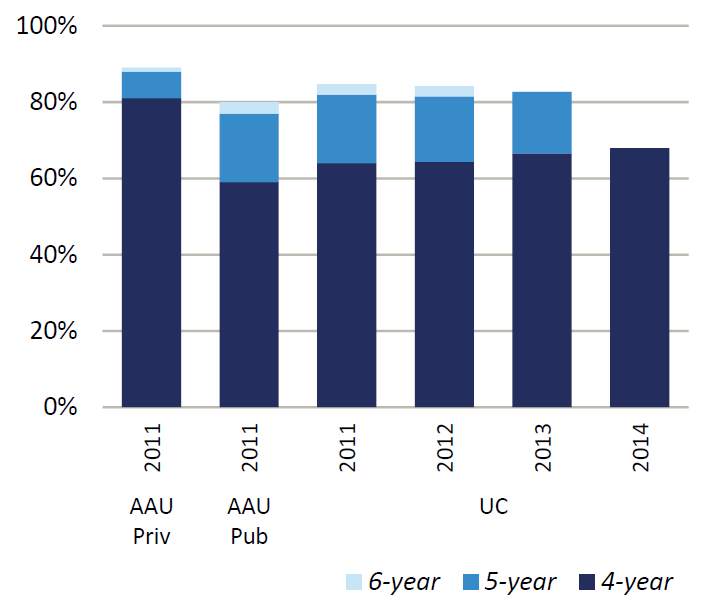
3.1.3 Transfer graduation rates, Universitywide, Cohorts entering fall 2014, 2015, and 2016
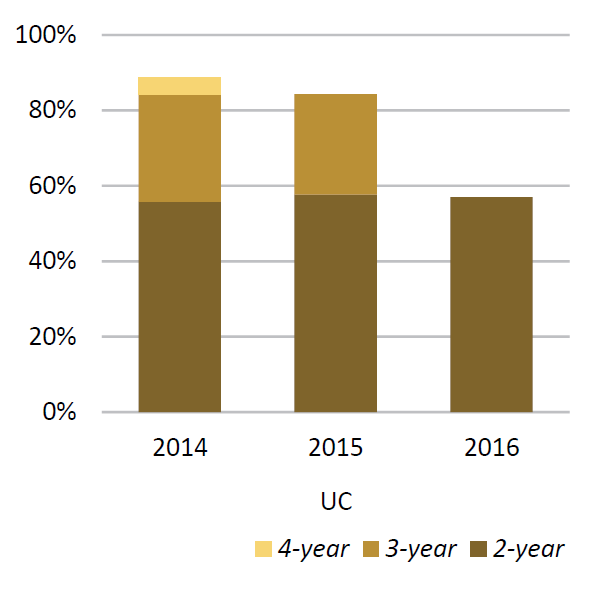
Source: UC Data Warehouse and IPEDS
Of the additional 200,000 degrees UC will produce, over 40,000 will be graduate degrees, and this growth will primarily be achieved through increased graduate enrollment across the system. Not only will this growth support degree attainment goals, it will increase the share of graduate students across the system, currently at 21 percent, compared to 27 percent for non-UC AAU public institutions and 55 percent for AAU private institutions (4.2.1). This graduate growth will also support both undergraduate degree attainment through teaching and mentorship, while advancing UC research activities. Increasing graduate enrollment will help achieve degree attainment goals and stem the decline in the share of graduate students across the system.
4.2.1 Graduate enrollment share of total, Universitywide, fall 2000 to fall 2018 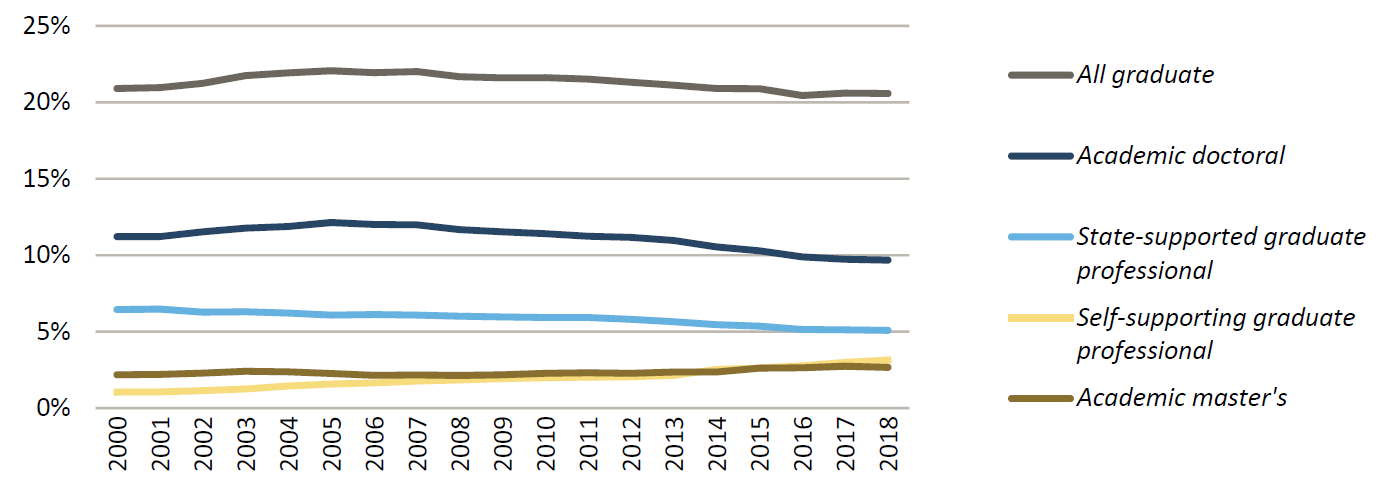
Source: UC Corporate Student System. Academic master’s students include post-baccalaureate, teaching-credential students. Graduate professional includes professional master’s (e.g., M.B.A., M.Ed.) and professional practice (e.g., J.D., M.D.) degrees
Goal 2: Ensuring the California Dream is for everyone
The emphasis of this goal is two-fold: ensuring that nine out of ten freshman and transfer entrants leave UC with a degree, and eliminating timely graduation gaps for first-generation, Pell grant, and underrepresented students.
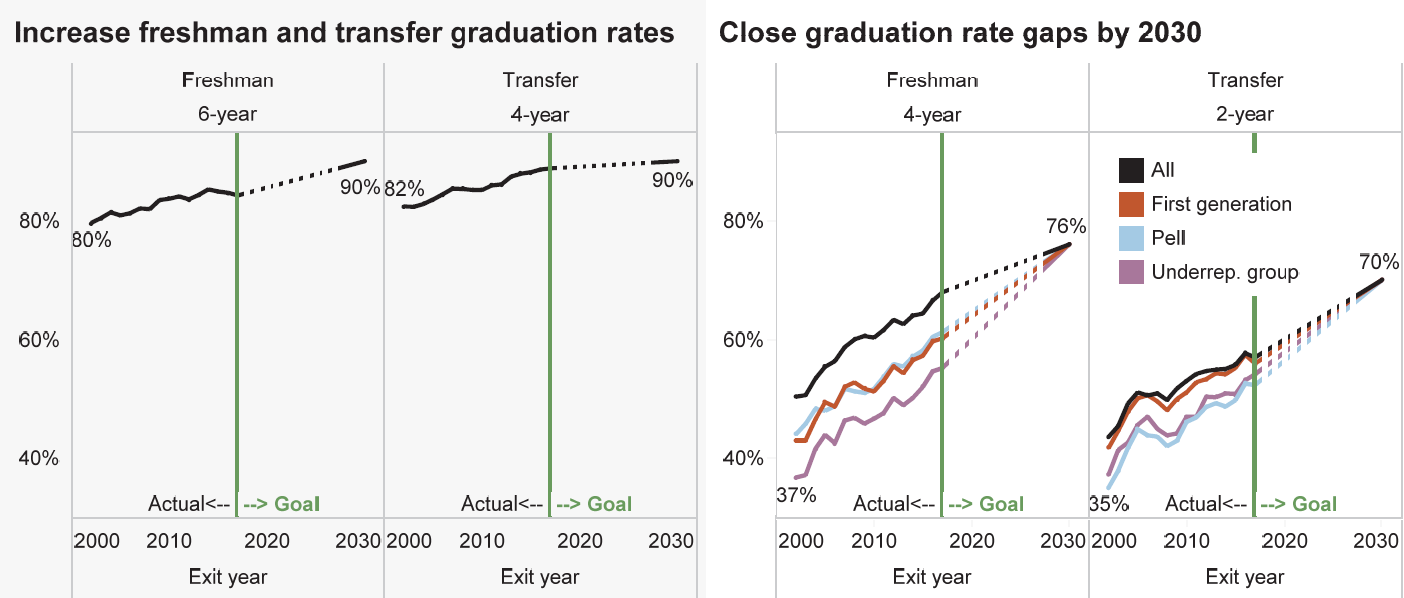
Over the last 15 years, UC graduation rates have improved, particularly four-year freshman and two-year transfer graduation rates. However, UC has been unable to close gaps in timely graduation for Pell, first-generation, and underrepresented groups, particularly for freshman entrants. UC is seeking to eliminate double-digit gaps in timely graduation rates for Pell, first-generation and underrepresented students.
UC’s gap in timely graduation is more than ten points for Pell and non-Pell recipients.
3.1.6 Freshman graduation rates by Pell Grant recipient status, Universitywide, Cohorts entering fall 2012, 2013, and 2014

3.1.7 Transfer graduation rates by Pell Grant recipient status, Universitywide, Cohorts entering fall 2014, 2015, and 2016
UC’s gap in four-year graduation rates is almost 20 points for underrepresented students compared to Asian and White peers.
3.1.4 Freshman graduation rates by race/ethnicity, Universitywide, Cohorts entering fall 2012, 2013, and 2014
One challenge to achieving these ambitious goals is a recent decline in first-year retention rates, around one percentage point for freshman and transfer entrants. These drops coincide with a period when UC increased enrollment significantly but did not receive full state support. First-year retention has dropped even further for freshman entrants who are underrepresented (two percentage points), Pell grant recipients (almost two percentage points), and first-generation (1.5 percentage points), exactly the populations UC is targeting to eliminate graduation gaps. These data emphasize the importance of investment to reverse this trend and also highlight that even with investment, UC may see a drop in graduation rates for these cohorts.
Freshman and transfer retention rates are high, but a recent decline forecasts likely drops in graduation rates.
3.2.1 First-year retention rates, UC systemwide, Cohorts entering fall 2008 to fall 2017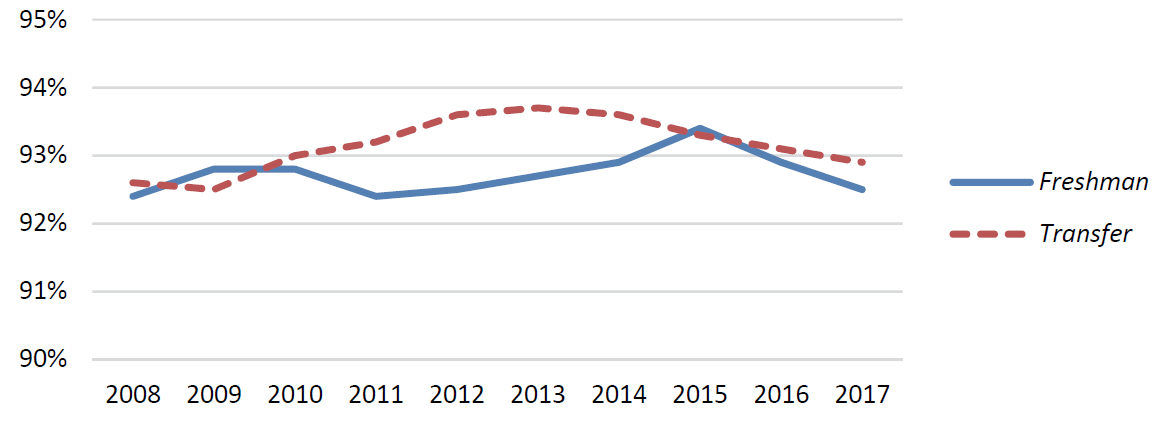
Source: UC Data Warehouse
Goal 3: Investing in the next generation of faculty and research
While much of the funding that supports UC research activity comes from the federal government, a primary way California supports UC research activity is through state support for faculty. Campuses estimated what they would need to achieve goals in the multi-year framework. Based on that input, the University has set a goal to add 1,100 net new faculty over the next four years.
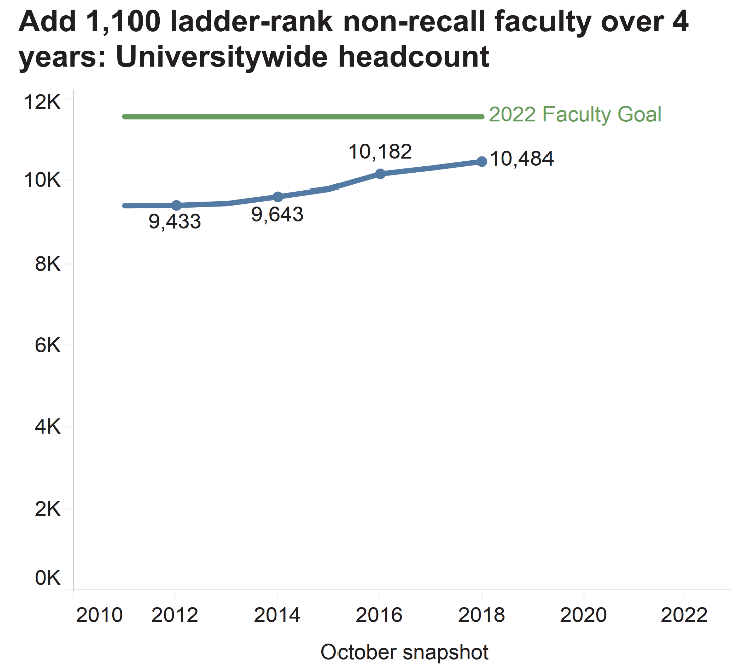
These additional faculty would help:
- Achieve undergraduate and graduate degree attainment goals, by adding course offerings, expanding student engagement and mentorship opportunities, and creating bachelor’s degree completion programs for undergraduates, along with expanding student mentorship and advising, and preparing the next generation of researchers, scholars, and professional graduate students
- Grow high-demand programs and create new academic programs, adding capacity in the fastest-growing disciplines where students are turned away and creating new undergraduate and graduate programs in emerging fields (e.g., sustainable and resilient urban systems, artificial intelligence and data science, public humanities and ethnic studies, and networking and cybersecurity)
- Grow research that addresses California’s needs and expands economic growth, increasing extramural funding coming into California, spurring economic growth, especially in the Central Valley and Inland Empire
- Grow UC’s research profile and expand translational research to meet societal needs (e.g., developing a smart energy grid, improving immigration and health care policy, understanding effects of climate change)
While many of the UC 2030 goals may take a decade to achieve, the goal to grow faculty is currently limited to the next four years. In part, this will help UC assess its efforts to further diversity the faculty, which will support student outcomes and benefit UC research. UC’s recent hires are more diverse than existing faculty and they meet or exceed national availability pools (5.3.1).
UC’s hiring of underrepresented and female faculty overall exceeds or meets the national availability of doctorates, with variation among discipline groups.
5.3.1 Underrepresented* new assistant professors compared with national availability by discipline group, Universitywide, 2013–14 to 2017–18
* Underrepresented at UC includes those who identify as Black/African American/African, Chicano/Latino/Hispanic, and American Indian/Native American.
5.3.2 Female new assistant professors compared with national availability by discipline group, Universitywide, 2013–14 to 2017–18
Source: UC Academic Personnel and Program Administration and Survey of Earned Doctorates
It warrants further attention that while UC has hired 1,000 more tenure-track faculty than have separated over the last decade, the percent of underrepresented faculty hired is lower than the percent separating from the University. Specifically, while faculty from historically underrepresented minority communities made up 14.3 percent of all tenure-track (Assistant Professor and Lecturer with Potential Security of Employment) new hires between 2008–09 and 2017–18, they comprised 15.7 percent of tenure-track separations and 15.3 percent of tenure-track resignations.
Faculty hires have exceeded separations by 1,000 over the last decade.
5.3.3 New hires and separations of ladder-rank and equivalent faculty, Universitywide, 2008–09 to 2017–18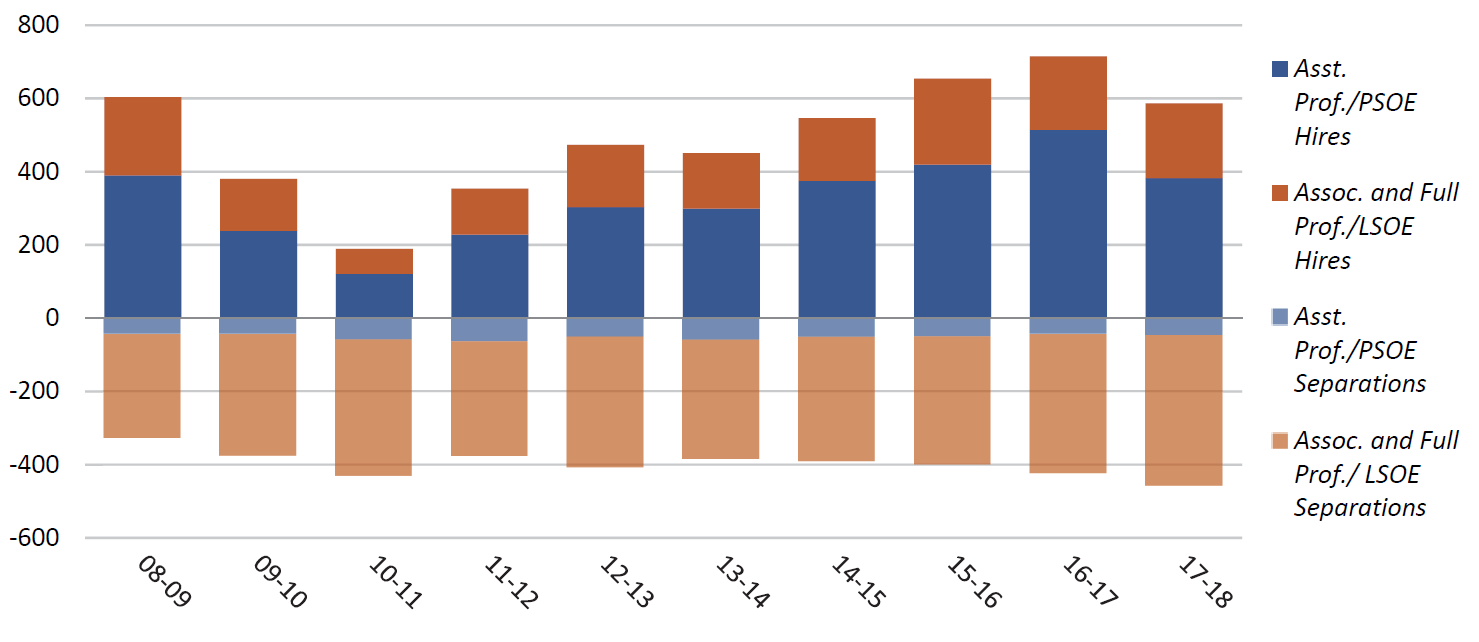
Source: UC Academic Personnel and Program Administration
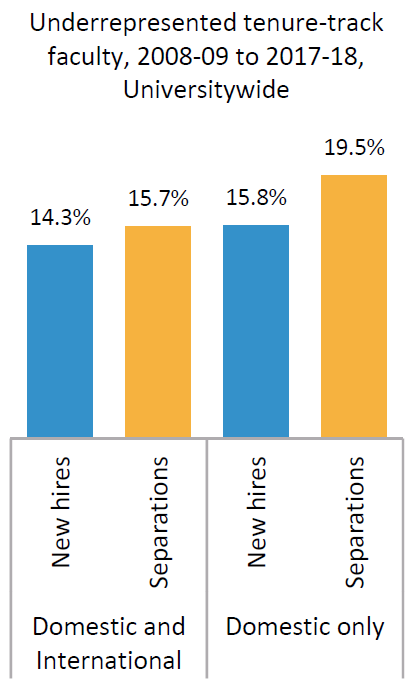
The University of California has a number of efforts underway to examine what contributes to these separations. For example, UC has partnered with Harvard’s Collaborative on Academic Careers in Higher Education (coache.gse.harvard.edu) on a research project to survey faculty who are actively retained as well as those who leave UC for employment elsewhere. This Retention and Exit Study, now in its fourth year, is part of an effort to better understand and improve the experience of UC faculty members, as well as improve recruitment and retention. UC faculty salaries lag those of comparison eight institutions (5.3.4). Early data show that salary is a critical factor in decisions to leave, emphasizing the importance of making UC salaries more competitive as UC seeks to further diversify the faculty.
UC faculty salaries are below the comparison institution benchmark.
5.3.4 Average ladder-rank general campus faculty salaries by rank, 2000–01 to 2018–19
Source: UC Corporate Personnel System, AAUP faculty salary survey
The University has laid out a vision on how it can support California’s future, with improved undergraduate and graduate degree attainment, the elimination of equity gaps, and the growth of the next generation of faculty and research. The University has proposed a multi-year funding proposal to achieve these ambitious goals, requesting an additional $60 million in permanent funding for each of the next four years, a funding proposal that is similar to the California State University’s Graduation Initiative 2025. Campuses have identified promising strategies and programs to direct additional resources, including:
- Programs that provide a fast start to successful and timely graduation, including pre-matriculation and orientation programs like summer bridge and transfer edge
- Engagement strategies to advance student success, including cohort-based learning communities, undergraduate research, and other discovery experiences
- Curricular innovations and expansion, including additional/redesigned course offerings needed to support timely graduation and growth of high-demand programs that some students have difficulty accessing
- Integrated approach to improving outcomes, such as academic, peer, and mental health support, basic needs support, data analytics, and expanded on-campus work study
- Growing the graduate and future professoriate pathway, including additional ladder-rank faculty to increase UC’s capacity to grow graduate student numbers
While some of this work is ongoing, the University’s request for additional funding will help campuses ramp up these efforts to achieve the ambitious goals — particularly improving outcomes and reducing costs of education for underrepresented, first-generation, and Pell grant recipient students. Today’s UC students receive less instructional support and are paying more than their peers did in prior years.
Since 1990–91, total instructional expenditures per UC student have declined by 20 percent, yet students and their families bear a greater share of that cost.
12.1.5 Average general campus core fund expenditures for instruction per student, 1990–91 to 2017–18
Source: UC Budget Office, inflation-adjusted amounts
State support to sustain core operations, along with strategies to address capital needs are critical to address alongside this multi-year framework funding. The partnership of the state and UC has produced a return on investment that has benefited California in the past and with sufficient resources, UC is confident it will continue to provide a positive return. UC will continue to track its progress to achieve these goals and partnering with the state, the University has a greater likelihood of success.
